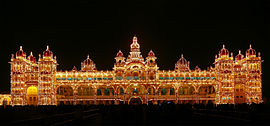
Back মহীশূর দশেরা Bengali/Bangla دسارای میسور Persian Mysore Dasara French मैसूर दशहरा Hindi Mysore Dasara ID ಮೈಸೂರು ದಸರಾ Kannada മൈസൂർ ദസറ Malayalam मैसुरु दसरा Marathi नवरात्रम् (मैसूरु) Sanskrit மைசூரு தசரா Tamil
(Top to bottom, L-R) Mysore Palace illuminated during the festival, procession of Goddess Chamundeshwari's idol, elephant procession on Vijayadashami | |
| Type | Cultural, Religious (Hindu) |
|---|---|
| Significance | Marking the victory of good over evil |
| Celebrations | Lighting Mysuru Palace, Ramayana theatre, mela (fairs), processions and parades |
| Begins | September/October per Hindu calendar |
| Ends | 10 days later |
| Frequency | Annual |
| First time | 17–27 September 1610 |
| Related to | Chamundeshwari (goddess Shakti), Durga, Mahishasura, The Ramayana, the Vijayanagara Empire, the Kingdom of Mysore, the Wadiyar dynasty |
Mysore Dasara is the state festival in the state of Karnataka in India. It is a 10-day festival, starting with nine nights called Navaratri and the last day being Vijayadashami. The festival is observed on the tenth day in the Hindu calendar month of Ashvina, which typically falls in the Gregorian months of September and October.[1][2][3]
The Hindu festival of Navaratri and its occasion of Vijayadashami celebrates the victory of good over evil. According to Hindu mythology, it commemorates the day the goddess Chamundeshwari (Durga) slew the demon Mahishasura.[4] Mahishasura is also believed to be the demon whose slaying by the goddess gave the city the name Mysuru. The Mysuru tradition celebrates the warriors and the state fighting for the good during this festival, ritually worshipping and displaying the state sword, weapons, elephants, horses, along with the goddess in her warrior form (predominantly) as well as the avatar of Vishnu, Rama. The ceremonies and a major procession is traditionally presided by the king of Mysuru.[4]
The city of Mysuru has a long tradition of celebrating the Dasara festival with grandeur and pomp to mark the festival. The Dasara festival in Mysuru completed 409th anniversary in the year 2019,[5] while evidence suggests the festivities were observed in Karnataka state by the Vijayanagara Empire kings in the 15th century.[6]
- ^ Encyclopedia Britannica 2015.
- ^ James G. Lochtefeld 2002, pp. 212–213, 468–469.
- ^ Encyclopedia Britannica Dussehra 2015.
- ^ a b Christopher John Fuller (2004). The Camphor Flame: Popular Hinduism and Society in India. Princeton University Press. pp. 114–126. ISBN 0-691-12048-X.
- ^ "400th Mysore Dasara begins today". The Times of India. 7 October 2010. Archived from the original on 6 November 2011.
- ^ Dasara of Mysore Archived 16 June 2018 at the Wayback Machine, All India Radio, Government of India


